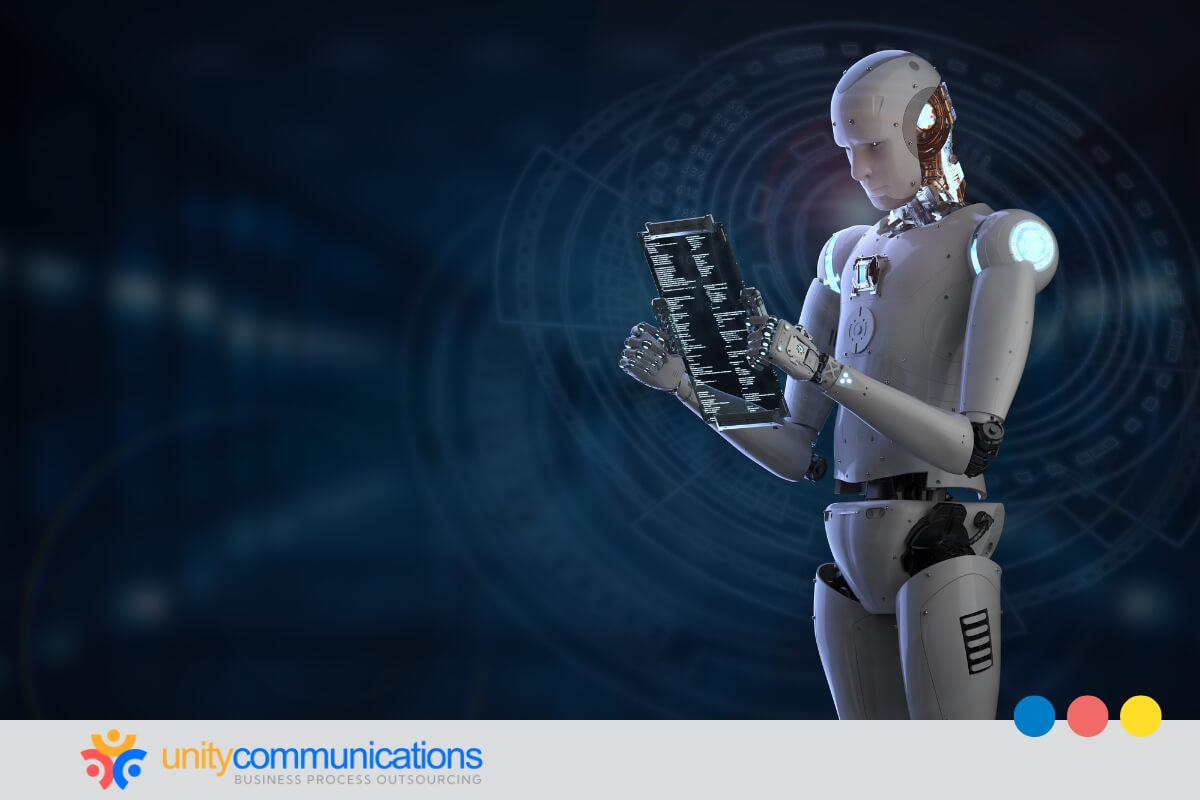Table of Contents
Artificial intelligence (AI) agents are transforming business operations, moving beyond simple automation to deliver intelligent systems that think, learn, and adapt. For enterprises exploring business process outsourcing (BPO), understanding how AI agents work has become critical for maintaining a competitive advantage.
Unlike traditional automation, which follows rigid scripts, AI agents analyze real-time data, make contextual decisions, and continuously improve performance.
This comprehensive guide reveals how AI agents work from their core architecture to real-world enterprise applications. You’ll discover the different types of AI agents, their cognitive mechanisms, and practical implementation strategies for BPO environments.
We’ll also address the challenges and governance frameworks essential for successful deployment.
What are AI agents, and how do they function?

What is an AI agent? At its core, it is a system designed to sense, process, and act within digital or real-world environments. This raises interest in how an AI agent works for chief information officers (CIOs) and technology leaders, particularly in outsourcing contexts where automation reshapes operations.
When you examine the rising demand for more innovative outsourcing models, AI agents stand out as flexible tools that streamline workflows. Their applications range from BPO contact centers to financial services, providing scalable support while reducing overhead costs for enterprises aiming to expand their digital footprint.
This section defines AI agents and their core functions, then explains how outsourcing providers use them to power advanced services.
Defining AI agents: Beyond traditional automation
An AI agent begins with its role as a digital actor that perceives inputs and generates outcomes aligned with business goals.
Market studies show strong growth, with the global AI agent segment valued at $5.25 billion in 2024 and expected to hit $52 billion by 2030. This reflects accelerating adoption across industries.
AI agents are not abstract concepts but practical solutions driving measurable outcomes. Outsourcing firms increasingly adopt them to support operations where cost control and agility matter most.
Understanding how an AI agent works is critical when evaluating long-term strategies for enterprise resilience.
Core functions that drive business value
AI agents fulfill several roles in enterprise systems, from automated support to decision augmentation. Research highlights that over 82% of businesses already engage with AI, signaling its relevance across industries and in outsourced operations.
This adoption is no longer optional. You encounter AI agents in multiple scenarios:
- Automating customer support across time zones
- Optimizing supply chain responses to demand shifts
- Strengthening fraud detection for financial outsourcing
- Powering analytics in healthcare and human resources (HR) services
These roles highlight why enterprises turn to BPO vendors who integrate AI agents into service delivery. This sets the stage for understanding how AI agents are designed and operate.
The architecture behind AI agent intelligence
Understanding the architecture of AI agents helps you see their value in BPO operations. These systems can sense, interpret, and act. However, their effectiveness comes from a layered structure.
For CIOs, data leaders, and technology heads, the focus lies in how an AI agent works across diverse service models. By looking at the design, you’ll notice that every AI agent is divided into interconnected modules.
These modules manage functions ranging from perception and reasoning to action and communication. The result is a system that handles routine work and integrates with outsourcing providers’ platforms for scalable service delivery.
Here, we move from basic functions to the structural design that powers them, exploring core modules and their integration.
Four essential components of an AI agent architecture
To understand how an AI agent works, you must examine its underlying architecture. Think of it as a sophisticated digital brain with interconnected modules that work together seamlessly.
Every effective AI agent contains four core modules that enable intelligent behavior:
- Sensory input interface. This collects data from multiple sources, including text, voice, images, and system logs. Advanced agents can process multimodal inputs simultaneously, combining written customer complaints with voice tone analysis.
- Cognitive processing engine. The “brain” interprets inputs using natural language processing, machine learning algorithms, and predictive analytics. This module determines what the data means and what appropriate actions might be.
- Memory and context system. This stores interaction history, learned patterns, and contextual information. It enables agents to maintain coherent conversations and improve responses over time.
- Action and response interface. This interface executes decisions through various channels, such as sending emails, updating databases, initiating workflows, or interfacing with other systems.
These four modules illustrate how an AI agent functions as a digital brain. By linking input, processing, memory, and action, agents deliver smart, scalable, and adaptable automation.
How components enable intelligent behavior
Modules do not function in isolation. They work in sequence, sharing information across the architecture to simulate decision-making. The reasoning engine relies on memory, while output layers depend on accurate inputs.
This interaction chain defines how an AI agent works in real-world use. BPO providers benefit from this layered interaction, allowing agents to scale across industries with minimal reconfiguration. The result is intelligent automation that fits seamlessly into service delivery models.
Types of AI agents: Reflex, goal-based, utility-based, and learning
Can AI replace call center agents? You might ask this when considering automation in outsourcing environments. The answer depends on the type of AI agent used, because each functions differently.
You must examine its operational model to understand how an AI agent works. Reflex, goal-based, utility-based, and learning agents address unique challenges enterprises face in expanding global service delivery.
This section introduces their roles before discussing distinct behaviors.
Reflex and goal-based agent characteristics
Reflex agents operate on immediate responses, following simple rules without deeper reasoning. For instance, in outsourcing, they can handle repetitive inquiries by detecting specific triggers in customer messages. They are efficient for high-volume, routine interactions.
Goal-based agents, on the other hand, evaluate actions against defined objectives. Instead of just reacting, they assess whether a step advances the process toward a target. In outsourcing, these agents support tasks such as onboarding or claims resolution, where progress depends on meeting specific outcomes.
- Reflex agents: Rule-driven, predictable responses
- Goal-based agents: Action chosen relative to defined objectives
- Reflex agents: Excel in fast decision cycles without complex analysis
- Goal-based agents: Provide flexibility where outcomes depend on defined paths
Both types highlight how outsourcing providers can optimize basic functions with scalable automation.
Utility-based and learning agent behavior
Utility-based agents measure the desirability of outcomes to select the best course of action. They are valuable in contact centers where customer satisfaction scores influence decision-making, as the agent prioritizes actions with the highest expected benefit.
Learning agents take this further by adapting to new inputs and experiences. They refine performance over time, which supports outsourcing vendors who must deliver consistency across industries.
By combining adaptation with decision evaluation, the system shows how an AI agent works dynamically instead of following fixed rules.
- Utility-based agents prioritize by calculating the value of outcomes.
- Learning agents improve performance with experience and adaptation.
- Utility-based agents weigh trade-offs before responding to inquiries.
- Learning agents build historical knowledge that sharpens accuracy.
This progression demonstrates that not all AI agents are alike. Their behavior depends on architecture and purpose, directly influencing their role in enterprise outsourcing strategies.
The cognitive engine: How AI agents think and decide
CIOs and enterprise leaders usually ask how intelligent and robotic process automation (RPA) handles choices in complex business contexts. To address this, you need to see the cognitive mechanisms at work.
They determine how an AI agent works, from interpreting input to executing decisions that scale outsourced operations. For outsourcing partners, understanding these mechanisms directly relates to measurable outcomes.
Firms adopt AI-driven processes because they connect efficiency with decision quality, which studies tracking the RPA impact on BPO operations reflect. Agents are judged by their speed and their consistency in managing priorities.
These mechanisms can be broken down into three core areas:
- Decision-making processes that weigh multiple inputs
- Planning functions that set steps toward goals
- Memory systems that store context across interaction
Each element builds on the others, forming the foundation of intelligent behavior. Let’s examine the decision-making side first.
Decision-making processes and strategies
Decision-making in AI agents reflects structured evaluation of available options. You interact with these systems when they prioritize service tickets, detect transaction anomalies, or assign workflows in shared platforms.
This is not random automation but a guided response shaped by reasoning models. In practice, this gives BPO organizations measurable gains. Enterprises working across multiple geographies rely on AI-driven decision-making to meet complex demands.
Agents apply business rules, probability weighting, and adaptive models to choose the best real-time action.
Understanding how an AI agent works in practice
The “thinking” process extends beyond a single action. To truly grasp the inner workings of an AI agent, you must see how planning and memory coordinate to support continuity. Memory stores prior interactions, while planning defines the steps necessary for future outcomes.
This layered process is vital when evaluating automation in the BPO industry. Service providers use it to deliver faster responses in claims processing, payroll assistance, or multilingual support. With memory and planning combined, AI agents give enterprises speed and accuracy without straining internal teams.
When decision-making, planning, and memory align, enterprises gain automation that delivers scale and resilience.
Single-agent vs. multi-agent systems: Choosing the right architecture

When evaluating outsourcing automation, you examine whether a single or multiple agents handle a task. This distinction matters because it affects how processes scale across geographies and functions.
A single-agent model focuses on independent cognition, while multi-agent systems extend capabilities through coordination and division of work. Understanding how an AI agent works in these two contexts helps you decide which design fits enterprise priorities.
Single-agent systems: Independent intelligence
A single-agent system operates independently, interpreting inputs and producing outputs without relying on other agents. This model is helpful in outsourcing environments where functions are isolated and do not require collaboration.
You see single-agent designs applied in:
- Customer inquiry routing based on predefined logic
- Document classification for claims processing
- Transaction monitoring in finance outsourcing
- Automated invoice matching in accounts payable workflows
- Data entry validation for HR records or compliance forms
- Basic chatbot interactions for frequently asked questions (FAQs) and scripted responses
- Task-specific automation, such as payroll calculation runs
These systems highlight predictability, straightforward oversight, and reduced integration complexity. Their value rests in how an AI agent works independently when tasks are well-bounded.
Multi-agent systems: Collaborative intelligence at scale
Multi-agent systems take a different approach by distributing tasks among several agents that interact and adapt. Instead of isolated action, these systems function as networks that exchange information and collectively resolve challenges. In outsourcing contexts, this means higher flexibility and scale. Examples include:
- Virtual teams of agents handling multilingual customer support
- Supply chain coordination where agents share updates across vendors
- Distributed fraud detection agents monitoring global transaction flows
- Knowledge-sharing bots that cross-train systems for complex cases
- AI agents managing omnichannel support across email, chat, and voice
- Collaboration in RPA-driven environments where multiple bots share workload
These interactions demonstrate how system-level collaboration expands capabilities beyond what a single agent can achieve. By shifting from individual cognition to shared operations, enterprises see the benefits of speed, resilience, and adaptability.
These interactions demonstrate how system-level collaboration expands capabilities beyond what a single agent can achieve. For businesses outsourcing functions, shifting from individual cognition to shared operations boosts cost efficiency, scalability, and delivery, enabling providers to meet enterprise demands.
Advanced capabilities: Generative AI and multimodal integration
AI agents handle more than repetitive tasks. Advanced systems combine generative AI and multimodal integration to process complex workflows and provide intelligent responses.
Understanding how an AI agent works in these scenarios helps you evaluate solutions for BPO environments and operational efficiency. These capabilities offer a foundation for scaling services and reducing operational overhead.
The following subsections highlight practical applications for enterprises leveraging AI-driven outsourcing solutions.
Generative AI: Creating intelligent content and responses
Generative AI equips agents to produce responses, summarize data, and suggest actions based on context. You can leverage this for reasoning, communication, or content generation tasks. Applications in outsourcing include:
- Drafting customer support messages with an appropriate tone
- Summarizing claims or invoices for faster approval
- Recommending actions in HR or payroll workflows
- Producing knowledge articles for internal teams
- Generating personalized marketing content for campaigns
- Automating internal reporting with clear narratives
- Assisting in document translations for global clients
Generative AI also supports predictive guidance, demonstrating how an AI agent works beyond traditional rule-based automation and helping enterprises reduce manual effort while maintaining consistency.
Multimodal integration: Processing complex information streams
Multimodal AI allows agents to process multiple types of information, including text, audio, images, and structured data. This capability enhances decision-making and communication for outsourcing operations.
- Analyzing voice calls alongside chat transcripts
- Processing scanned forms and digital documents
- Combining customer sentiment with transaction histories
- Delivering outputs through multiple channels, including visual dashboards
- Identifying anomalies in images or scanned receipts
- Cross-referencing audio cues with support ticket data
- Supporting interactive tutorials with voice, text, and video guidance
These integrations provide flexibility, allowing BPO firms to manage complex tasks efficiently and respond to diverse client needs.
The role of machine learning (ML) in BPO is crucial for teaching agents to interpret data, identify patterns, and make recommendations. By leveraging ML, agents adapt to changing workflows, improve accuracy, and reduce manual effort in high-volume outsourced operations.
Combining AI and BPO enables enterprises to scale complex services without adding headcount. Intelligent agents handle repetitive tasks while human teams focus on higher-value work.
These features highlight advanced capabilities that enhance both single-agent and multi-agent systems.
Real-world applications and enterprise use cases
AI agents have moved beyond theoretical models into tangible business solutions that affect BPO strategies. When you explore a use case for AI in customer service, you notice how agents streamline call handling, speed up resolution, and maintain a consistent tone across customer interactions.
This highlights how an AI agent directly influences operational efficiency. For enterprises shifting to scalable BPO models, technology decisions align with infrastructure strategies.
One area gaining attention is outsourcing contact centers to the cloud, which reduces on-premises costs while allowing AI agents to integrate easily across geographies. This approach provides a framework for scaling service delivery with agility.
Industry success stories and measurable impact
AI agents are not limited to one field. They are integrated across industries to manage diverse operational requirements.
For instance, virtual assistants continue to gain traction, with one leading solution surpassing 88 million active users. This shows that businesses and consumers alike value intelligent, context-aware responses.
The benefits are equally significant in healthcare. AI agents can now resolve 95% of patient inquiries, giving doctors and nurses more time for critical care tasks.
These real-world applications illustrate how an AI agent works across high-stakes sectors and demonstrate adaptability that enterprises can replicate in outsourcing models.
You encounter their use in areas such as:
- Financial auditing workflows supported by automated checks
- Retail inventory monitoring linked with predictive restocking
- Logistics route planning optimized with real-time data
- Human resource onboarding guided by conversational bots
Solving enterprise challenges with AI agents
Enterprises rely on AI to address practical challenges that limit scalability and efficiency. To understand what BPO is, you must also recognize how AI agents strengthen its foundations by delivering automation that reduces overhead while improving accuracy.
Adoption patterns show momentum among smaller enterprises as well. Recent analysis indicates that AI adoption by SMBs will climb to 78% in 2025, revealing how accessible automation has become. AI agents are not limited to large corporations but extend value across the enterprise spectrum.
Building and deploying AI agents: From development to production
When evaluating enterprise automation, you consider system architecture and the steps required to put agents into production. Development and deployment shape how efficiently these systems scale across outsourced environments.
Understanding how AI agents work in these contexts helps you align platform choices with business outcomes. The following subsections highlight development frameworks and deployment practices.
Essential development tools and frameworks
Building AI agents involves selecting frameworks that balance flexibility, integration, and governance. As a technology leader, you look for platforms that support modular design while connecting to enterprise data pipelines. Common toolsets include:
- TensorFlow and PyTorch for training custom models
- LangChain for managing reasoning across prompts and memory
- Rasa for conversational agents tailored to business workflows
- Microsoft Bot Framework for integration within enterprise environments
- Cloud-native software development kits (SDKs) offered by Amazon Web Services, Google Cloud, and Microsoft Azure
Each option offers different strengths, from low-code deployment to advanced customization. These frameworks provide the foundation for extending functionality across outsourcing providers who require scale and reliability.
Deployment strategies and risk management
Deploying agents requires weighing governance, scalability, and operational control. In outsourcing environments, deployment choices directly affect cost structure and service continuity.
Adoption data illustrates the landscape. Only 14% of financial institutions reported developing all fraud-focused AI and ML systems internally, while nearly 29% indicated that they depend entirely on third-party providers. This shows the balance between building in-house and relying on external platforms.
Key practices to prioritize include:
- Testing agents within controlled sandbox environments before production
- Establishing monitoring dashboards for response accuracy and latency
- Applying compliance filters for industry-specific regulations
- Deploying across distributed cloud regions to support global delivery
- Structuring fallback workflows for sensitive use cases
In this context, you also evaluate how outsourcing works, since third-party providers might deliver platform-ready agents that integrate with enterprise systems more quickly than internal builds.
These patterns highlight how an AI agent works during deployment, where resilience and adaptability matter most for outsourced operations.
By focusing on frameworks and best practices, enterprises gain a clear pathway to production-ready systems that align with outsourcing strategies and enterprise goals.
Measurable business impact: Why AI agents deliver real ROI

When considering enterprise automation, you measure both operational impact and strategic value. For BPO services, agents improve delivery quality, reduce overhead, and expand capacity.
These outcomes also illustrate BPO advantages that decision-makers closely evaluate. The subsections below show where efficiency and measurable returns come into play.
Improving operational efficiency and productivity
AI agents directly enhance productivity by handling large portions of repetitive interactions. Studies indicate that intelligent systems can manage about 80% of customer engagements, which allows your teams to prioritize complex requests that require more profound expertise.
By shifting volume to agents, response times shorten, and resolution rates rise. You also benefit from measurable productivity gains.
Research highlights that AI-driven automation contributes to a 25% increase in workforce output across industries. This impact aligns with outsourcing environments where agents reduce manual effort while elevating service quality.
The connection to operational efficiency is apparent as you evaluate deployment. You see efficiency applied in areas such as:
- Ticket routing and triage across global contact centers
- Payroll adjustments completed without manual intervention
- Real-time policy updates pushed into HR platforms
- Claims analysis executed with contextual reasoning models
- Supplier inquiries resolved across procurement workflows
These gains reinforce how an AI agent works to improve everyday processes while lowering overhead.
Strategic value and measurable return in business
Beyond efficiency, AI agents provide strategic impact. You assess investments by examining how returns scale with business priorities. Agents improve customer satisfaction, expand operational reach, and maintain consistency across distributed teams.
This supports outsourcing providers that must deliver at enterprise-grade standards. As you explore return on investment (ROI), the decision hinges on platform adaptability and integration speed.
Understanding how an AI agent works helps you decide where to apply automation for measurable outcomes. ROI extends beyond cost savings to include resilience, agility, and long-term scalability. Examples of value delivered include:
- Faster market entry with automated onboarding
- Reduced compliance risk with integrated audit trails
- Broader service reach through multilingual support
These benefits align business strategy with practical delivery improvements, strengthening the case for adopting AI agents in outsourced operations.
Managing risks: Governance frameworks for responsible AI deployment
When weighing the benefits of automation in outsourcing, you must also address the challenges of adopting intelligent systems. For enterprises, these challenges include ethical, operational, and compliance considerations directly affecting outsourcing reliability.
As a decision-maker, you also examine BPO risks and drawbacks, since performance failures or poorly governed systems can impact service delivery and client trust. Here, we discuss the major areas you must evaluate before scaling deployment.
Identifying and mitigating ethical and operational risks
AI agents promise efficiency but also bring risks that affect business outcomes. You must account for transparency, accountability, and potential bias in decision-making. If systems behave unpredictably, the impact spreads across outsourced operations. Enterprises commonly encounter challenges such as:
- Algorithmic bias leads to inconsistent service delivery.
- Data privacy gaps expose sensitive customer information.
- System downtime disrupts time-sensitive processes.
- Escalation bottlenecks occur when agents cannot hand off to humans.
- Limited adaptability occurs when facing unstructured, ambiguous requests.
- Vendor dependency reduces long-term operational flexibility.
- High integration costs with legacy systems are slowing adoption.
Understanding how an AI agent operates helps you spot these risks early, since visibility into decision paths is necessary to maintain control. IT leaders consistently view interpretability as a foundation for reliable deployment.
Governance frameworks and compliance measures
To scale outsourcing effectively, you need robust governance that keeps operations compliant with industry regulations. Decision makers evaluate governance as a business requirement, not an afterthought.
Strong frameworks address oversight and alignment between technical teams and business leaders. Examples include:
- Adopt explainability protocols that clarify reasoning models.
- Implement compliance checks across financial, healthcare, or HR use cases.
- Apply version control and audit trails for agent decisions.
- Establish accountability layers between outsourcing vendors and enterprise stakeholders.
- Build escalation protocols that blend automation with human oversight.
- Conduct ongoing risk assessments tied to regulatory changes.
- Train staff to interpret and validate automated outputs.
These safeguards help you track how AI agents process tasks in environments where oversight is critical. When governance frameworks align with operational practices, you reduce risk exposure and improve service delivery consistency.
By addressing these challenges with structured governance, enterprises position AI agents to deliver reliable outcomes in outsourced environments.
The bottom line
Understanding how AI agents work is just the first step toward operational transformation. Enterprises integrating AI agents into their BPO strategies gain significant competitive advantages through improved efficiency, enhanced customer satisfaction, and reduced operational overhead.
Whether you’re considering single-agent solutions for specific tasks or multi-agent systems for complex workflows, the technology has matured to support enterprise-grade implementations.
Success depends on selecting the right approach for your requirements: balancing technical capabilities with governance frameworks that ensure responsible, compliant deployment.
Ready to deploy AI agents in your enterprise? Let’s connect and explore how intelligent agents can elevate your business performance and support growth.




